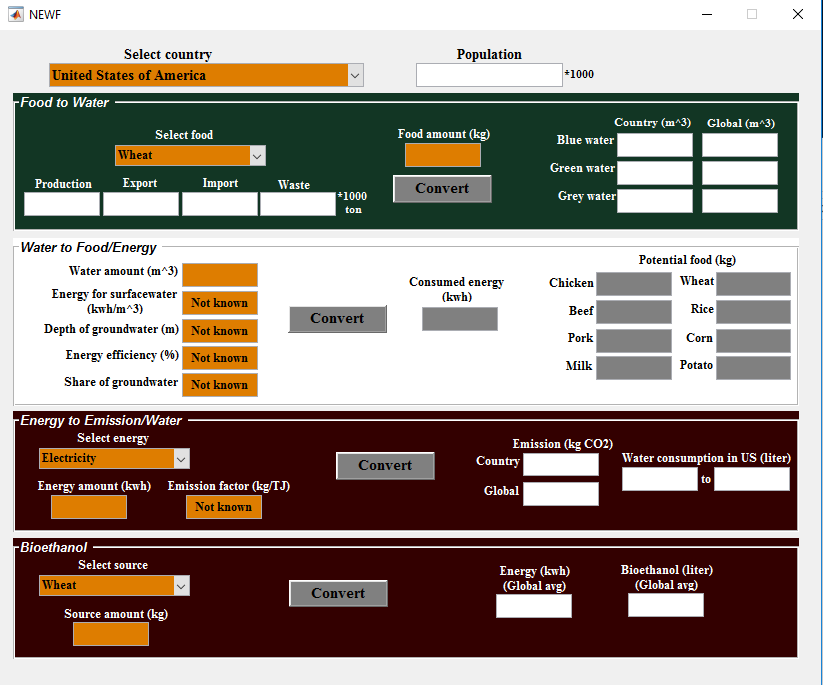Summary of instructions to use the NEWF toolbox:
Purpose and Description: Nexus of Energy Food Water (NEWF) toolbox is developed to convert a selected amount of one element in the nexus to the other two at a global scale and the country level, if data availability allows. We strived to provide country specific data for this computation, but this is not warranted for all conversions depending on data availability. Data that is used in this study are obtained from FAO, World Bank, and USDA, among others. NEWF toolbox is user friendly and interactive. The orange boxes and drop downs are the ones that user needs to provide, and white boxes print the outputs of the toolbox analysis. In this
How to Run:
Make sure to change the directory of matlab, to the directory that you saved the NEWF files in.
GUI:
Run “NEWF.m” in matlab to open up the graphical user interface.
User is prompted to choose a country name from the “drop down” and toolbox will print out the country population as of 2013 (last available data).
Food to Water:
User should select the type of food from the “drop down” and input the amount (in kg) and hit convert. NEWF returns the amount of production, export, import and waste of this food type in the selected country, as well as the amount of equivalent (blue, green, grey) water for the inserted amount of the food type in the selected country and also the global average.
Water to Food/Energy:
User needs to insert the amount of water. If available, (s)he should also provide the amount of energy per cubic meters required for extract/transfer/treat surface water, and depth of the ground water, energy efficiency and share of the groundwater in the supplied water. Depth of ground water and energy efficiency are used to compute the energy required for groundwater extraction. If these information are not available, NEWF will use a global average of 0.37 kwh/m^3 for surface water and 0.48 kwh/m^3 for ground water. Also share of groundwater in total water supply for many countries is available, and if not provided it will be extracted from the available data set. For those countries that lack such data, a global average will be used, which undermines the accuracy of the results of course. Moreover, potential amount of certain foods that could be produced with this amount of water in the selected country will also be reported to the user.
Energy to Emission/Water:
In this section type of energy should be selected as well as amount of energy. If the emission factor (kg/TJ) is known, it will improve the accuracy of computation, if not then country average can be extracted from the available data. This will return the emission for the energy amount and type provided for the selected country as well as global average. Moreover, the amount of water that is consumed in the United States to extract/purify/produce such amount of energy, depending on the source and type of technology, is reported as an uncertainty range. Different technologies have different water footprint so the uncertainty range could be large.
Bioethanol:
Source crop and its amount are converted to the amount of energy (kwh) and bioethanol volume (liter) in this section. Global average values are reported in this section.
